By Philip Cauchi
Introduction: Training the back four on its own is just suitable for beginners to help them understand its principles. If we are working with more advanced players, training the back four should be integrated with the team. The communication and level of integration of the back four does not exist in a vacuum. This means that the behaviour of the back four depends not only on its four members but also on its relation with the midfielders, opponents in direct confrontation with our back line and the opponents inserting themselves into the attack.
In matches it can be noticed several times how full backs apply pressure on the opposite winger or lateral midfielder while being covered by the closest midfielder. Other times we see midfielders helping the central defender double team an opponent or simply adjusting their position to protect the back line and prevent the opponents from playing vertically. Practicing without these important components makes training less realistic and there will be less transfer of learning to the match.
Aim of session: To remain compact and prevent opponents from gaining space and time to finish at goal.
Session outcomes:
1. Remain compact within the same line (distances between the player in the back four).
2. Compactness with the midfield line (distances and angles of coverage).
3. Recognising the moment when to push forward with the team – opponent with the ball under pressure.
4. Recognising the moment when to drop – no pressure on the opponent with the ball.
5. Defending the ball on the flank – full back presses while being covered by the closest midfielder.
6. Midfielders to mark potential receivers between the defence and midfield lines.
7. Central defenders to remain centrally if possible so to outnumber opponents in central areas and also have the best players to deal with crosses.
Warm-up: Defending shadow play.
Duration: 20 minutes
Outcomes: 1, 2, 5 and 6.
The players start warming-up by performing various running coordination, dynamic stretches, mobility exercises and other injury prevention routines. Following this part of the warm-up, we will then have one team acting as the defending team where their main aim is to move according to the movement of the ball, while being able to only intercept passes made by the opponents; therefore no tackling. The defending team must work together to put pressure on the attacking team and force them into making mistakes.
As we are still in the warm-up phase do not allow the attacking team to play long balls. Intersperse this period with dynamic stretching and mobility exercises. Have both teams switch roles every two minutes. End the warm-up with six maximal sprints of four to five seconds in duration. The goalkeepers warm-up with the goalkeepers coach.
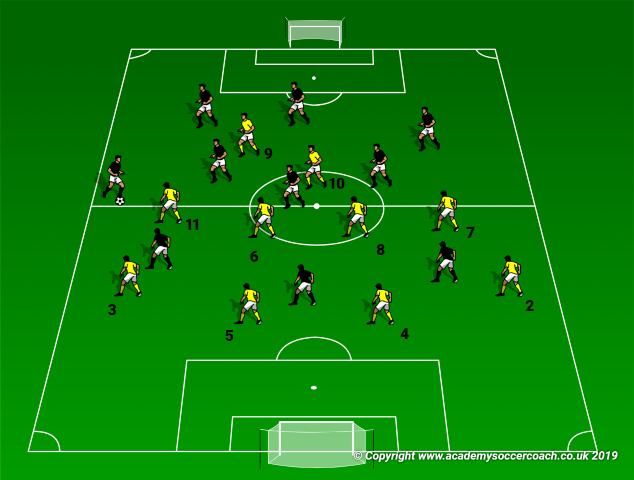
During this specific warm-up ask the players to think about the shape of the team when they are not in possession of the ball. Ask them also to reflect about their own position in relation to the rest of the team, opponents and the ball. Let them work out together a way of how they can win the ball through applying the correct positioning of the team, without making use of tackles.
Main: Global game 11v11.
Duration: 18 minutes – 2 x 8 minutes with a two minute rest in between.
Outcomes: All.
We start playing a normal game of 11v11. The reason is simple! We want our players to communicate together in the same manner they did during the warm-up. Although now the intensity is game like as it should always be in training. Playing a global game at the beginning enables the players to associate the practices that follow with what happens in real situations during a match.
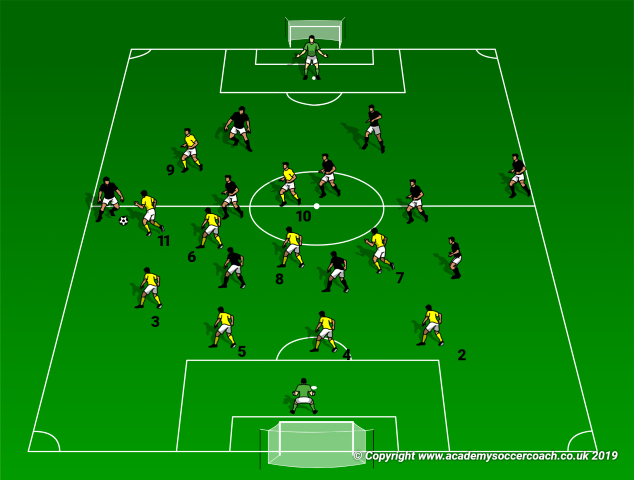
To challenge a team more make them play with a man less (alternate players who will step out of the field and practice on their own until being substituted by another teammate). Take players off from different lines, thus making the team work cohesively of how they will adjust in such a situation during a match. This will definitely develop teamwork and enhance the level of communication on the field of play.
Main: Playing in a confined area.
Duration: 12 minutes – 2 x 5 minutes with a two minute rest in between.
Outcomes: All.
Teams play in an area measuring the width of the pitch by forty five yards in length. The aim of this game is for both teams to score by guiding (dribbling or passing) the ball beyond the opposition team’s goal line which is the whole width of the field. This forces both teams to put immediate pressure on the ball, or drop and retain compactness. The goalkeepers practice with the goalkeepers’ coach.
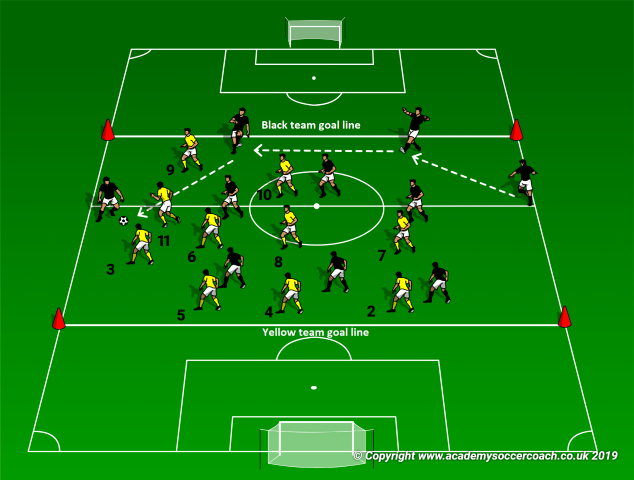
If this proves to be a higher challenge than the players can handle, reduce the width of the pitch as necessary. The ultimate aim of this exercise is to work on the compactness of the team as a whole and correct the angles and distances between the midfield and defence sectors. Furthermore, we will also be working towards developing our team’s behaviour to quickly initiate counter attacks when regaining possession of the ball.
Main: Drop or hold the line?
Duration: 12 minutes – 2 x 5 minutes with a two minute rest in between.
Outcomes: All.
All players are to remain inside their assigned zone. We coach the yellow team; i.e. the team that is defending. We have the back four against the opposition’s three strikers in the area between the centre line and the red markers. In the blue zone we have the midfield line and the two strikers against the back four and three midfielders. Play always starts from inside the marked blue area.
The black team tries to play the ball through the midfield and into the strikers’ feet or by playing long behind the yellow team’s defensive line. If this occurs, the situation becomes a 4v4+GK for the yellow team to defend and the black team to attack. After the attack is over, play restarts again from inside the blue zone by the black team’s goalkeeper.
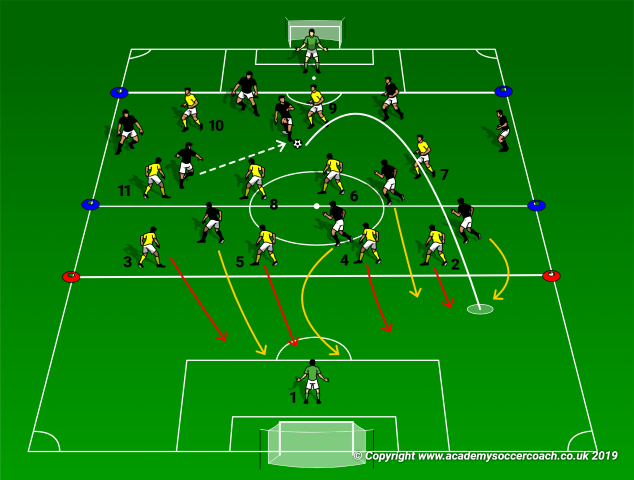
The midfielders and strikers should work together to prevent the opponents from playing direct balls behind the yellow team’s defensive line or into their strikers’ feet. If there is no pressure on the ball and the ball-carrier adapts a stance as if to kick long, the back four should drop in anticipation. If the long ball is not played, they should move back into their assigned area.
Main: Global game 11v11.
Duration: 18 minutes – 2 x 8 minutes with a two minute rest in between.
Outcomes: All.
We return to the game in its global context. We should now focus on the back four’s behaviour when the team is not in possession of the ball. Do the players in back line retain compactness between them? What about the distance between the back line and midfield sector? If the full back applies pressure on the opposition’s winger, who covers him? Is the midfield line guarding the space between them and the back four? Are they properly positioned to block forward passes? If an opponent drops in this space, is the closest midfielder marking him? Do we retain numerical superiority at the back?
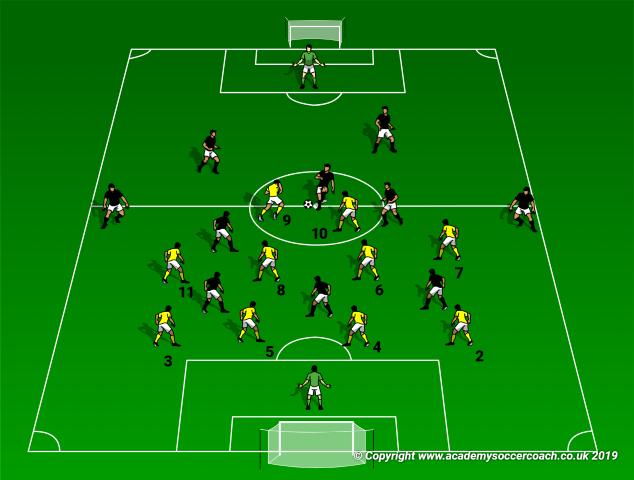
Conclusion
In the last ten minutes the players perform light passing exercises in groups of three or four prior to concluding the session with static stretching exercises. Players should hold each stretch for approximately twenty seconds while targeting the lower body and lumbar area.
By Philip Cauchi


